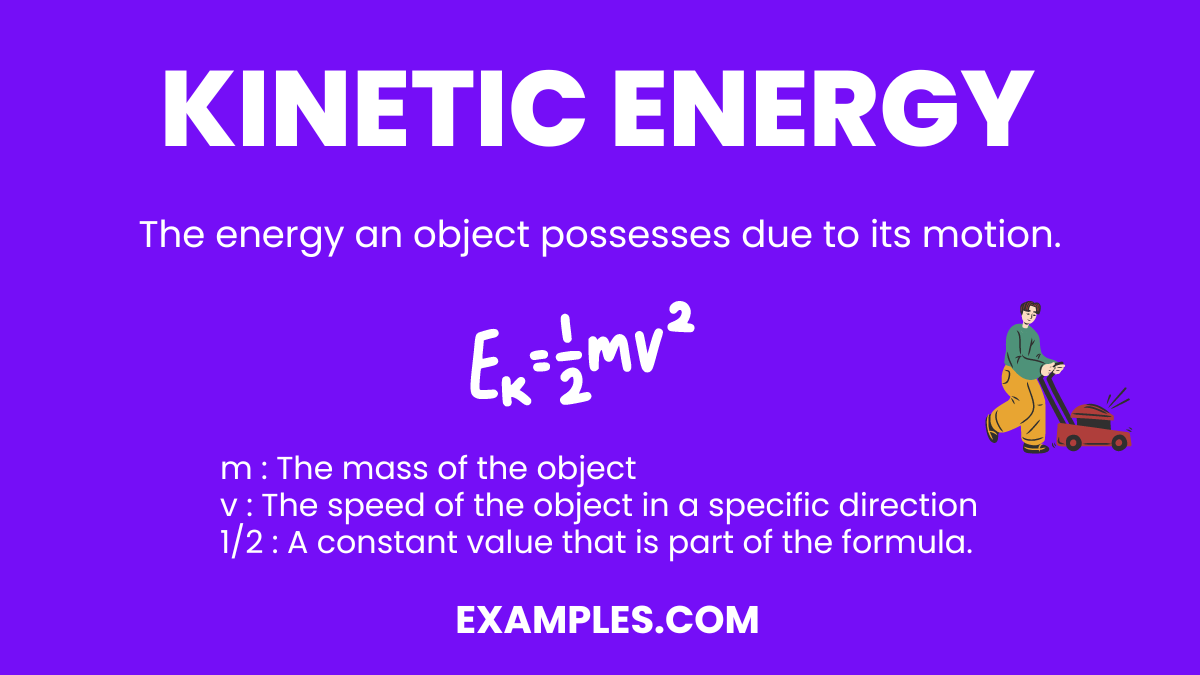What is the kinetic energy of a 2 kg object moving at a speed of 3 m/s?
3 J
6 J
9 J
18 J


Kinetic energy powers our world, from the smallest particles to the grandest celestial bodies. This guide illuminates the essence of kinetic energy through practical examples and accessible explanations. Ideal for students, educators, and the scientifically curious, it transforms a complex concept into a clear, graspable idea. Join us on this journey to uncover the pivotal roles kinetic and potential energy play in our everyday lives and beyond.
Kinetic energy is the energy found in moving objects, from the simplest to the most complex. When you see someone walking, a baseball flying through the air, a crumb tumbling from a table, or even a charged particle moving in an electric field, you’re observing kinetic energy in action. It’s an important concept to understand: any object in motion possesses kinetic energy, while a stationary object has none.
Kinetic energy is the energy an object gains due to motion. When we apply a force to an object, causing it to move, we’re doing work on it. This work transfers energy to the object, causing it to accelerate and gain kinetic energy. This energy is determined by two key factors: the object’s mass and its speed.
Kinetic energy isn’t just about straightforward movement from one point to another. It includes various types of motions like rotation, vibration, or a mix of different movements. It’s a versatile form of energy that can be transferred between objects and even transformed into other energy types.
Consider a flying squirrel colliding with a stationary chipmunk. In this scenario, some of the squirrel’s kinetic energy might transfer to the chipmunk or change into another form of energy. Such examples are great for illustrating the dynamic nature of kinetic energy in the classroom.
One of the best examples of kinetic energy is a flying arrow. When an archer pulls back the bowstring, they store potential energy. Once released, this energy converts into kinetic energy, propelling the arrow forward. This transformation illustrates the core principles of kinetic energy: energy conversion, motion, and the impact of mass and velocity. The arrow’s journey from bow to target is a clear, real-world demonstration of kinetic energy in action.
The SI unit of kinetic energy is the Joule (J), which is a kg?m2/s?2. The English unit of kinetic energy is the foot-pound (ft?lb). Kinetic energy is a scalar quantity. It has magnitude, but no direction.
The kinetic energy formula is a fundamental equation in physics, essential for understanding how motion translates into energy. Represented as KE = 0.5 x mv², where KE stands for kinetic energy, ‘m’ is the mass of the object, and ‘v’ is its velocity, this formula provides a quantitative measure of energy due to motion. Here’s a breakdown:
KE = 1/2 m v2
Kinetic energy is a captivating concept in physics, illustrating energy in motion. It’s essential for teachers and students to grasp this idea through real-world examples. Our list provides a diverse range of instances where kinetic energy is at play, making the concept tangible and easier to understand. Each example showcases the dynamic nature of kinetic energy, from everyday occurrences to more complex applications. This collection is designed to enrich teaching methods and enhance students’ comprehension and vocabulary in English.
Kinetic energy, the energy of motion, is an integral concept in physics and everyday life. This energy type is present in every moving object and can be categorized into different forms based on the nature of the movement. Understanding these types helps in comprehending various physical phenomena and their applications. Let’s explore the types of kinetic energy, providing descriptions and examples for each.
Translational kinetic energy is the energy possessed by an object due to its linear motion. It’s the most common form we observe in daily life.
Rotational kinetic energy is the energy an object has due to its rotation around an axis. This type of kinetic energy is crucial in objects that turn or spin.
Vibrational kinetic energy is found in objects that are vibrating. This energy type is often observed at the molecular or atomic level.
Orbital kinetic energy is the energy possessed by objects in orbit, like satellites or planets. It’s a combination of translational and rotational kinetic energy.
Elastic kinetic energy is observed in objects that are stretched or compressed and then released, like in elastic materials.
Each of these kinetic energy types plays a vital role in different physical contexts. For teachers, these examples provide a practical and relatable way to illustrate the diverse applications of kinetic energy in both natural phenomena and engineered systems. Understanding these forms enhances students’ grasp of fundamental physics concepts and their ability to apply this knowledge in real-world scenarios.
Kinetic energy is omnipresent in our daily activities. This energy form, derived from motion, is integral to how we interact with the world. From jogging in the park to the moving cars on the street, kinetic energy is a dynamic force fueling our everyday life.
Inside our homes, kinetic energy is an unseen but essential force. Household activities and objects are prime examples of kinetic energy in action, making our daily routines smoother and more efficient.
Kinetic energy is not just limited to theory; it’s vividly present in numerous real-life situations. Understanding these examples helps grasp the practical aspects of physics in our surroundings.
Understanding the distinction between kinetic and potential energy is crucial for comprehending the broader concept of energy in physics. While kinetic energy relates to motion, potential energy is all about the position or state of an object. Both play pivotal roles in the study of physics and are fundamental in explaining various natural phenomena and engineering applications.
| Aspect | Kinetic Energy | Potential Energy |
|---|---|---|
| Definition | Energy an object possesses due to its motion. | Energy stored in an object due to its position or state. |
| Dependence | Depends on the mass and velocity of the object. | Depends on the position relative to other objects. |
| Types | Usually involves motion (e.g., linear, rotational). | Includes gravitational, elastic, chemical, and more. |
| Energy Conversion | Transformed from potential energy when an object moves. | Converted to kinetic energy when the condition changes. |
| Example | A car moving on a highway. | A stretched bowstring before release. |
| Measurement | Measured using the formula: KE = 0.5 x mv². | Measured based on the type (e.g., PE = mgh for gravitational). |
| Real-Life Scenario | The energy of a sprinting athlete. | Energy in a compressed spring. |
In conclusion, kinetic energy, the energy of motion, is a vital concept in physics and everyday life. From moving cars to flowing rivers, it illustrates how objects in motion harness energy. This guide aims to assist teachers in explaining kinetic energy to students, enhancing their comprehension of physics and its real-world applications, thus enriching their learning experience.
Text prompt
Add Tone
22 Kinetic Energy Examples
Kinetic Energy Examples in Daily Life
What is the kinetic energy of a 2 kg object moving at a speed of 3 m/s?
3 J
6 J
9 J
18 J
If the speed of an object is doubled, what happens to its kinetic energy?
It is doubled
It is halved
It remains the same
It is quadrupled
A car of mass 1500 kg is moving at a speed of 20 m/s. What is its kinetic energy?
300,000 J
150,000 J
600,000 J
1,500,000 J
Which of the following factors does not affect the kinetic energy of an object?
Mass
Speed
Height
None of the above
A 0.5 kg ball is thrown with a speed of 10 m/s. What is its kinetic energy?
5 J
10 J
25 J
50 J
If the kinetic energy of an object is 50 J and its speed is 5 m/s, what is its mass?
2 kg
4 kg
5 kg
8 kg
A 12 kg object is moving with a speed of 5 m/s. What is its kinetic energy?
75 J
100 J
125 J
150 J
A 1.5 kg ball is dropped from a height of 10 m. Ignoring air resistance, what is its speed just before hitting the ground? (Use g = 9.8 m/s²)
10 m/s
14 m/s
20 m/s
30 m/s
A 20 kg object moving at 5 m/s doubles its speed. What is its new kinetic energy?
250 J
500 J
1000 J
2000 J
A baseball of mass 0.145 kg is pitched at 40 m/s. What is its kinetic energy?
58 J
116 J
232 J
290 J
Before you leave, take our quick quiz to enhance your learning!

